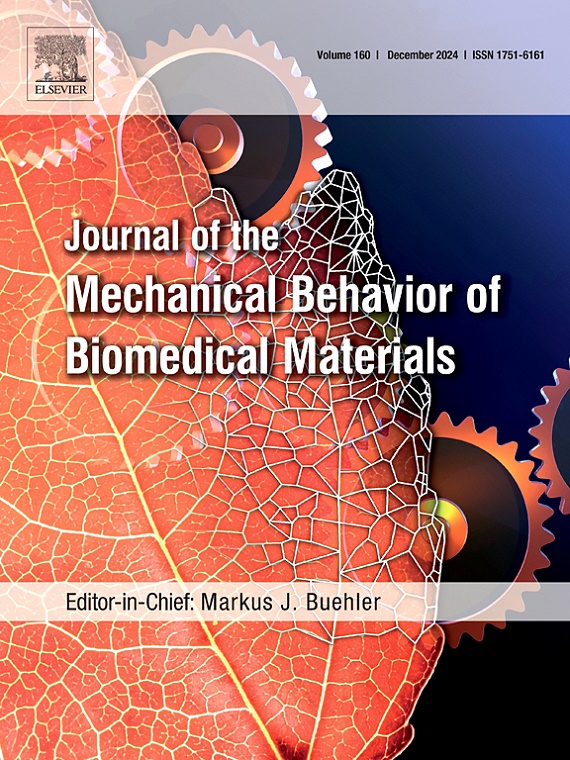Mechanical response of avian skeletal muscle under quasi-static and dynamic uniaxial compression
IF 3.5
2区 医学
Q2 ENGINEERING, BIOMEDICAL
Journal of the Mechanical Behavior of Biomedical Materials
Pub Date : 2025-06-13
DOI:10.1016/j.jmbbm.2025.107103
引用次数: 0
Abstract
Mitigating aeroengine damage from bird-aircraft collisions is crucial to prevent economic losses and even loss of human lives. Because engine testing and validation is often expensive, aircraft engineers depend on computational simulations to maximize engine component protection against high-speed bird-strike events at reduced cost. Since the bulk of a bird's mass is comprised of skeletal muscle, developing an insight into this mechanical behavior is crucial for understanding the muscle tissue's loading, recovery, and breakup behavior within the engines. In this work, we aim to quantify the compressive mechanical response of avian skeletal muscle tissue. Experimental sample preparation protocols and testing procedures were first established to ensure consistent conditions that aim to reproduce the behavior of a live avian muscle specimen subjected to external loads. The samples were then tested in directions parallel and perpendicular to the muscle fibers, and under uniaxial quasi-static and dynamic compression across various strain rates. Avian skeletal muscle was generally observed to be strain-rate dependent for both compression directions. The samples further demonstrated an anisotropic mechanical response under compressive loading, where samples compressed perpendicular to the direction of muscle fibers exhibited markedly stiffer behavior than their parallel counterparts. The current work provides an initial understanding of the avian skeletal muscle mechanical behavior, which can potentially be developed for high-fidelity computational simulations and experiments at relevant engine operational conditions.
鸟类骨骼肌在准静态和动态单轴压缩下的力学响应
减轻鸟-机碰撞造成的航空发动机损坏对于防止经济损失甚至人员伤亡至关重要。由于发动机测试和验证通常是昂贵的,飞机工程师依靠计算模拟来最大限度地保护发动机部件免受高速鸟击事件的影响,同时降低成本。由于鸟类的大部分重量是由骨骼肌组成的,因此深入了解这种机械行为对于理解肌肉组织在发动机内的负荷、恢复和分解行为至关重要。在这项工作中,我们的目标是量化鸟类骨骼肌组织的压缩力学响应。首先建立了实验样品制备方案和测试程序,以确保一致的条件,旨在重现受外部载荷作用的活禽肌肉标本的行为。然后在与肌肉纤维平行和垂直的方向,以及在不同应变率下的单轴准静态和动态压缩下对样品进行测试。鸟类骨骼肌通常观察到应变速率依赖于两个压缩方向。样品进一步证明了在压缩载荷下的各向异性力学响应,其中垂直于肌肉纤维方向压缩的样品比平行的样品表现出明显的刚性行为。目前的工作提供了对鸟类骨骼肌力学行为的初步了解,这可能会在相关发动机工作条件下进行高保真计算模拟和实验。
本文章由计算机程序翻译,如有差异,请以英文原文为准。
求助全文
约1分钟内获得全文
求助全文
来源期刊

Journal of the Mechanical Behavior of Biomedical Materials
工程技术-材料科学:生物材料
CiteScore
7.20
自引率
7.70%
发文量
505
审稿时长
46 days
期刊介绍:
The Journal of the Mechanical Behavior of Biomedical Materials is concerned with the mechanical deformation, damage and failure under applied forces, of biological material (at the tissue, cellular and molecular levels) and of biomaterials, i.e. those materials which are designed to mimic or replace biological materials.
The primary focus of the journal is the synthesis of materials science, biology, and medical and dental science. Reports of fundamental scientific investigations are welcome, as are articles concerned with the practical application of materials in medical devices. Both experimental and theoretical work is of interest; theoretical papers will normally include comparison of predictions with experimental data, though we recognize that this may not always be appropriate. The journal also publishes technical notes concerned with emerging experimental or theoretical techniques, letters to the editor and, by invitation, review articles and papers describing existing techniques for the benefit of an interdisciplinary readership.
 求助内容:
求助内容: 应助结果提醒方式:
应助结果提醒方式:


